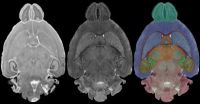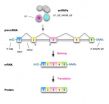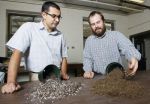(Press-News.org) In scientific publishing, how much reuse of text is too much? Researchers at the Virginia Bioinformatics Institute at Virginia Tech and collaborators have shown that a computer-based text-searching tool is capable of unearthing questionable publication practices from thousands of full-text papers in the biomedical literature.
The first step in the process is to find out what is restated before zeroing in on who may have crossed an ethically unacceptable threshold. The findings, published in PLoS ONE, offer hope for curbing unethical scientific publication practice, a growing problem throughout the world.
"Building upon our earlier work reported in Science and Nature, which uncovered ethically questionable journal articles by comparing their abstracts, we have now re-tuned our computer program, eTBLAST, to scan thousands of full-text articles in PubMed Central, a freely available repository of full-text biomedical literature," said Harold "Skip" Garner, author on the paper and executive director of the Virginia Bioinformatics Institute. "Our goal was to measure how much and where in papers – for example, the introduction, methods or results sections – text is duplicated to establish the 'norm' in publishing. This will allow ethicists, which we are not, to begin to develop guidelines as to what is and what is not acceptable publication practice."
Although abstract search is an effective approach to detect potential plagiarism, full text analysis is needed to uncover all potential duplicate citations in the scientific literature. The researchers examined 72 011 full-text articles using the eTBLAST computer program, which is only the tip of the iceberg for the number of published biomedical articles in the archives.
"We found that most papers are novel, as expected in scientific reporting, but even in papers reporting novel results, certain sections, such as the introduction or methods section, frequently have large amounts of content that appear elsewhere," said Garner. The researchers went on to explain that the re-use of text in certain sections, such as the methods section of papers, where authors provide details on how the work was done, is not a bad thing because it is important to use the accepted and most consistent techniques. "We also expect that other sections like the results section to be very unique just like the abstract. And this is the case in the overwhelming majority of papers," said Garner.
The current study revealed that the introduction section tended to be copied the most in similar citations. Also review articles were confirmed as being particularly prone to repetition.
"We believe this type of research will help us write better, more informative scientific papers, and prepare reviewers and journal editors for interpreting the similarity results that are emerging from the computational analysis of scientific papers. This approach is becoming increasingly commonplace as part of the scientific review process," added Garner. "Before crossing the line between acceptable and unacceptable writing, it is important to know the location of the line," concluded Garner.
INFORMATION:
The work was supported by the Hudson Foundation and the National Institutes of Health/National Library of Medicine. The paper is the 100th article funded by the US Department of Health & Human Services Office of Research Integrity.
Link to the PLoS ONE article: http://www.plosone.org/article/info%3Adoi%2F10.1371%2Fjournal.pone.0012704
Related links
Plagiarism sleuths
http://www.sciencemag.org/cgi/content/full/324/5930/1004
A tale of two citations
http://www.nature.com/nature/journal/v451/n7177/full/451397a.html
END
VIDEO:
This video contains more on the pediatric bone cancer preclinical study.
Click here for more information.
BOSTON - Researchers have identified an important signaling pathway that, when blocked, significantly decreases the spread of pediatric bone cancer.
In their study, researchers at The University of Texas MD Anderson Children's Cancer Hospital in Houston found that blocking the Notch pathway in mice decreased metastases in the lungs 15-fold. The results of ...
DURHAM, N.C. – The most detailed magnetic resonance images ever obtained of a mammalian brain are now available to researchers in a free, online atlas of an ultra-high-resolution mouse brain, thanks to work at the Duke Center for In Vivo Microscopy.
In a typical clinical MRI scan, each pixel in the image represents a cube of tissue, called a voxel, which is typically 1x1x3 millimeters. "The atlas images, however, are more than 300,000 times higher resolution than an MRI scan, with voxels that are 20 micrometers on a side," said G. Allan Johnson, Ph.D., who heads the ...
PHILADELPHIA - When most genes are transcribed, the nascent RNAs they produce are not quite ready to be translated into proteins - they have to be processed first. One of those processes is called splicing, a mechanism by which non-coding gene sequences are removed and the remaining protein-coding sequences are joined together to form a final, mature messenger RNA (mRNA), which contains the recipe for making a protein.
For years, researchers have understood the roles played by the molecular machines that carry out the splicing process. But, as it turns out, one of those ...
Even if a woman is perfectly clear in expressing sexual interest or rejection, young men vary in their ability to remember the cues, a new University of Iowa study shows.
Overall, college-age men were quite good at recalling whether their female peers – in this case, represented through photos – showed interest. Their memories were especially sharp if the model happened to be good looking, dressed more provocatively, and conveyed interest through an inviting expression or posture.
But as researchers examined variations in sexual-cue recall, they found two noteworthy ...
VIDEO:
Boston College DeLuca Professor of Biology Marc A.T. Muskavitch discusses his latest malaria research, published in the journal Science. Muskavitch and an international team of researchers developed the first high-resolution...
Click here for more information.
CHESTNUT HILL, Mass. (10/25/2010) – The development and first use of a high-density SNP array for the malaria vector mosquito have established 400,000 genetic markers capable of revealing new insights into how ...
Thanks to a microwave oven, the fundamental nanotechnology process of self assembly may soon replace the lithographic processing use to make the ubiquitous semi-conductor chips. By using microwaves, researchers at Canada's National Institute for Nanotechnology (NINT) and the University of Alberta have dramatically decreased the cooking time for a specific molecular self-assembly process used to assemble block copolymers, and have now made it a viable alternative to the conventional lithography process for use in patterning semi-conductors. When the team of chemists and ...
Turning up the heat might be the best thing for athletes competing in cool weather, according to a new study by human physiology researchers at the University of Oregon.
Published in the October issue of the Journal of Applied Physiology, the paper examined the impact of heat acclimation to improve athletic performance in hot and cool environments.
Researchers conducted exercise tests on 12 highly trained cyclists -- 10 males and two females -- before and after a 10-day heat acclimation program. Participants underwent physiological and performance tests under both ...
HOUSTON, Oct. 25, 2010 – Some unexpected effects of lead exposure that may one day help prevent and reverse blindness have been uncovered by a University of Houston (UH) professor and his team.
Donald A. Fox, a professor of vision sciences in UH's College of Optometry (UHCO), described his team's findings in a paper titled "Low-Level Gestational Lead Exposure Increases Retinal Progenitor Cell Proliferation and Rod Photoreceptor and Bipolar Cell Neurogenesis in Mice," published recently online in Environmental Health Perspectives and soon to be published in the print ...
WEST LAFAYETTE, Ind. - Greenhouse plant growers can substitute rice hulls for perlite in their media without the need for an increase in growth regulators, according to a Purdue University study.
Growing media for ornamental plants often consists of a soilless mix of peat and perlite, a processed mineral used to increase drainage. Growers also regularly use plant-growth regulators to ensure consistent and desired plant characteristics such as height to meet market demands. Organic substitutes for perlite like tree bark have proven difficult because they absorb the plant-growth ...
As the ice-capped Arctic Ocean warms, ship traffic will increase at the top of the world. And if the sea ice continues to decline, a new route connecting international trading partners may emerge -- but not without significant repercussions to climate, according to a U.S. and Canadian research team that includes a University of Delaware scientist.
Growing Arctic ship traffic will bring with it air pollution that has the potential to accelerate climate change in the world's northern reaches. And it's more than a greenhouse gas problem -- engine exhaust particles could ...





